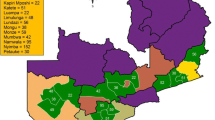Abstract
Four cattle breeds indigenous to western and south-western Ethiopia - Abigar, Gurage, Horro and Sheko - were included in a study of the perceptions of smallholder cattle keepers regarding cattle management, production levels and constraints for production. A semi-structured questionnaire was used and 60 cattle keepers from each of the four areas were interviewed. Diseases were reported as the main constraint to cattle production by a majority of livestock keepers in all areas except in the Sheko area, where over-stocking was the main constraint. Among diseases, trypanosomosis was the main livestock disease according to more than half of Gurage, Horro and Sheko keepers, whereas anthrax was most important in the Abigar area. Gurage had highest age at first calving, longest calving interval and also the lowest milk production, whereas Sheko and Abigar had the most favorable characteristics both for milk production (600–700 kg) and fertility (age at first mating 3–3.5 years and above 8 calves/cow). Cattle keepers in the Sheko area reported relatively less problems with cattle diseases compared to the other areas, especially regarding trypanosomosis. Abigar showed a different disease pattern than the other breeds and may also have advantages as regards trypanotolerance.


Similar content being viewed by others
References
Agyemang, K., Dwinger, R.H., Grieve, A.S., Bah, M.L., 1991. Milk production characteristics and productivity of N'Dama cattle kept under village management in the Gambia, Journal of Dairy Science, 74, 1599–1608
Alberro, M., Haile-Mariam, S., 1982. The indigenous cattle of Ethiopia. I, World Animal Review, 2–10
DAGRIS 2007. (Domestic Animal Genetic Resources Information). In http://dagris.ilri.cgiar.org.
d'Ieteren, G.D.M., Authie, E., Wissocq, N., Murray, M., 1998. Exploitation of resistance to trypanosomes. In: Axford, R.F.E., Bishop, S.C., Nicholas, F.W., Owen, J.B. (Ed.), Breeding for Disease Resistance in Farm Animals. Second ed. (CABI Publishing, Wallingford, England), pp. 195–216
Fall, A., Diack, A., Diaite, A., Seye, M., d'Ieteren, G.D.M., 1999. Tsetse challenge, trypanosome and helminth infection in relation to productivity of village Ndama cattle in Senegal, Veterinary Parasitology, 81, 235–247. doi:10.1016/S0304–4017(98)00213–1
FAO 2007. FAOSTAT. In http://faostat.fao.org/site/568/DesktopDefault.aspx?PageID=568.
Itty, P., Swallow, B.M., Rowlands, G.J., Mulatu, W., D'Ieteren, G.D.M., 1995. The economics of village cattle production in a tsetse-infested area of southwest Ethiopia, Preventive Veterinary Medicine, 22, 183–196. doi:10.1016/0167–5877(94)00409-C
Kristjanson, P.M., Swallow, B.M., Rowlands, G.J., Kruska, R.L., Leeuw, P.N.D., 1999. Measuring the costs of African animal trypanosomosis, the potential benefits of control and returns to research, Agricultural Systems, 59, 79–98. doi:10.1016/S0308–521X(98)00086–9
Lemecha, H., Mulatu, W., Hussein, I., Rege, E., Tekle, T., Abdicho, S., Ayalew, W., 2006. Response of four indigenous cattle breeds to natural tsetse and trypanosomosis challenge in the Ghibe valley of Ethiopia, Veterinary Parasitology, 141, 165–176. doi:10.1016/j.vetpar.2006.04.035
Mukasa-Mugerwa, E., Bekele, E., Tessema, T., 1989. Type and productivity of indigenous cattle in central Ethiopia, Tropical Animal Health and Production, 21, 120. doi:10.1007/BF02236190
Orenge, C.O., Kimwele, C.N., Korol, A.B., Kemp, S., Munga, L.K., Gibson, J.P., Hanotte, O., Murilla, G., Soller, M., 2008. Expression of trypanotolerant quantitative trait loci (QTL) in cattle population under natural tsetse and trypanosomosis challenge. Book of Abstracts for the 10th World Conference on Animal Production, Cape Town, South Africa, 19.
Ouma, E. A., 2007. Economic valuation of phenotypic cattle trait preferences in trypanosomosis prevalent production systems of Eastern Africa: Implications for sustainable cattle breeding programs. Doctoral thesis, Christian-Albrechts University, Kiel, Germany.
Peregrine, A.S., Mulatu, W., Leak, S.G.A., Rowlands, G.J., 1994. Epidemiology of bovine trypanosomiasis in the Ghibe Valley, Ethiopia: multiple-drug resistance and its effective control. In: Rowlands, G.J., Kyule, M.N., Perry, B.D. (eds.), Proceedings of the 7th International Symposium on Veterinary Epidemiology and Economics, (International Society for Veterinary Epidemiology and Economics, Nairobi, Kenya Veterinarian 18), 369–371
Rege, J.E.O., 1999. The state of African cattle genetic resources I. Classification framework and identification of threatened and extinct breeds, Animal Genetic Resources Information, No. 25, 1–25
Rowlands, G.J., Malatu, W., Authie, E., D'Ieteren, G.D.M., Leak, S.G.A., Nagda, S.M., 1994. Effects of trypanosomiasis on reproduction of East African zebu cows exposed to drug-resistant trypanosomes, Preventive Veterinary Medicine, 21, 237–249. doi:10.1016/0167–5877(94)90021–3
SAS 2001. SAS Version 8.2, SAS Institute Inc. (Cary, North Carolina).
Tadesse, M., Dessie, T., 2003. Milk production performance of Zebu, Holstein Friesian and their crosses in Ethiopia, Livestock Research for Rural Development, 15, 1–9
Trail, J.C.M., Hoste, C., Wissocq, Y.J., Lhoste, Ph., Mason, I.L., (1979). Trypanotolerant livestock in West and Central Africa, General study., ILCA Monograph. no. 2, ILCA, Addis Ababa (Ethiopia), FAO, Rome (Italy), UNEP, Nairobi (Kenya), 1,148.
Webb, P., Braun, J.v., 1994. Famine and food security in Ethiopia: Lessons for Africa, (John Wiley and Sons Ltd., Chichester, England)
WorldBank 2007. World Bank. In http://web.worldbank.org/WBSITE/EXTERNAL/COUNTRIES/AFRICAEXT/ETHIOPIAEXTN/0,menuPK:295955~pagePK:141132~piPK:141109~theSitePK:295930,00.html.
Acknowledgement
This study was carried out jointly between researchers of the Swedish University of Agricultural Sciences (SLU) and the International Livestock Research Institute (ILRI), as part of a larger study in breed evaluation for trypanotolerance in four Ethiopian cattle breeds, for which the collaboration with the Ethiopian Institute of Agricultural Research (EIAR) is gratefully acknowledged. Special thanks go to Dr. Yaregal Tadesse, Mr. Eshetu Zerihun, Mrs. Yetnayet Mamo and other technical staff at ILRI for assistance during the data collection. We would also like to thank the Animal Health Assistant Mr. Wube Tefera from Gambella, for assistance with data collection on Abigar, Mr. Takele Taye for data collection on the Sheko breed and all other research assistants that helped in the field. Livestock keepers in the four areas are greatly acknowledged for their participation in the study. We kindly thank the Swedish International Development Cooperation Agency (Sida) for providing the funding for the major part of this study.
Author information
Authors and Affiliations
Corresponding author
Rights and permissions
About this article
Cite this article
Stein, J., Ayalew, W., Rege, J.E.O. et al. Livestock keeper perceptions of four indigenous cattle breeds in tsetse infested areas of Ethiopia. Trop Anim Health Prod 41, 1335–1346 (2009). https://doi.org/10.1007/s11250-009-9319-6
Received:
Accepted:
Published:
Issue Date:
DOI: https://doi.org/10.1007/s11250-009-9319-6




